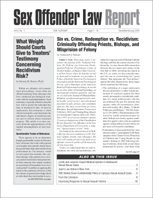Sexually Violent Predators—The View From Central Office Administration
Author: Olivia J. Garland, Ph.D..; Steven C. Wolf, Ph.D..
Source: Volume 15, Number 06, October/November 2014 , pp.81-87(7)

< previous article |next article > |return to table of contents
Abstract:
Creating a sexually violent predator (SVP) program is a complex undertaking involving multiple stakeholders who have competing value systems and often opposing purposes. Civil commitment statutes can initially provide a feeling of safety for the uneasy public by incapacitating those who are perceived to be the “worst of the worst.” But as the years pass, members of the public and legislators can become increasingly frustrated with the costs involved with such a program as well as the expenditure of time spent to address litigation, complaints, and evaluations for recommitment. This article examines how one state, Virginia, has evolved to improve services and establish prudent assessment and release policies to meet the often conflicting demands placed on SVP programs.Keywords: SVP statutes; Kansas v. Hendricks; STATIC-99; release from civil commitment
Affiliations:
1: Government Solutions for Optum; 2: Virginia Office of Sexually Violent Predator Services.